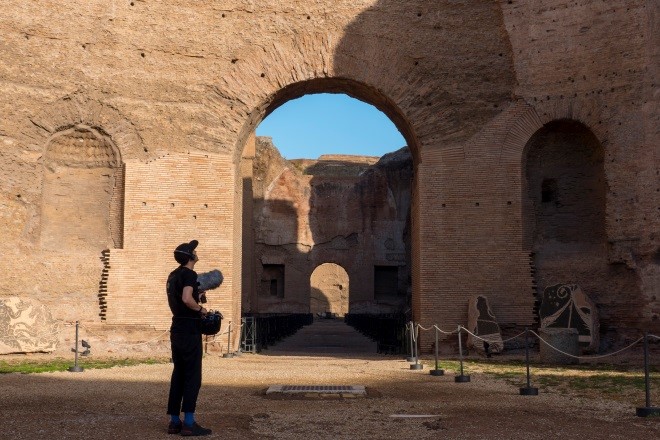By Matt Parker practice-based PhD candidate,
London College of Communication

image: Field Recording at Baths of Caracalla, Matt Parker 2017
Infrastructural Tourism and the vibrations of the Roman Palimpsest
At the time of applying for the UAL MEAD PhD Residency at The British School at Rome, I had been looking for avenues to pursue with my practice that would lead to interesting case studies and feature works that could be included in my final portfolio. As an artist whose primary interest is with site, listening, and sound, I have been researching modes of listening to media infrastructures; the physical, material sites of the Internet. I had become increasingly interested in tracing historicised but nonlinear narratives of communication infrastructure and the opportunity to spend a month studying communication infrastructures in one of the West’s premium historical cities struck a chord. How did mass communication work in ancient Rome? I was also struck by a statement made by the curator Jose Luis de Vicente who had described data centres as ‘modern day monuments’. As a major global tourist destination, Rome has become a site for remembering the palimpsestuous monuments of western civilization. In a city filled with monuments, how might these modern day communication monoliths hide in plain sight?

image: Field Recording at the Temple of Saturn, Matt Parker 2017
Once I began planning for the residency, I began to map various critical sites of infrastructure around the city as well as historical sites regarded as important locations for communication. I put a request list together and gave the BSR a list of desired locations I wanted to visit. The BSR has a relationship with many public and private institutions that allows them to make special requests called Permessi to grant access for scholarly research. I cast my net wide and hoped for the best. Sadly, none of the more contemporary sites responded well to my requests but I was pleased to receive Permessi to access The Forum, Palatine Hill, The Baths of Caracalla, and the Torre delle Milizie before they were open to the public. I began to alter my plans to fit accordingly.
In addition to this, I also contacted the six major data centre operators that exist within the Rome area and asked if I could meet with them to interview and see their sites. I received a few responses and IT Net’s Matteo Giampaolo offered to meet with me for a day at their data centre.

image: Field Recording inside IT Net Data Centre, Matt Parker 2017
As a field recordist and site based researcher, it is important for me to be in the field, actively engaging with site. Rome has no shortage of ancient fascinating historical sites and artefacts. It is impossible to avoid it. It also feels absolutely impossible for any non-Roman artist to make work in Rome that doesn’t involve antiquity in some way.
As such, I embarked producing a series of sound based video works that explored the compromises, conflicts, hypocrisy and banal everydayness of ancient Rome. Having been granted ‘special access’ I found myself recording in environments I had thought were considered sacred, and treated with reverence only to find that before opening hours, the staff at such sites just do their jobs; using lawnmowers, hedge trimmers, shovels, wheel barrows and smoking cigarettes. I aimed to breathe life back into these silent spaces by creating explosions in them, only to find there was plenty of life there already.

image: Still from Peak Wood (Film), Matt Parker 2017

image: Still from Palimpsest (Film), Matt Parker 2017

image: Producing Impulse Response Recordings, Matt Parker 2017
The British School at Rome is like some kind of fantasy land. It is a site of privilege and elitism. It is a site of scholarly curiosity, engagement and criticality. It is also a site of work for many service staff, all kind and wonderful to meet. I met other artists in the studios and scholars from other fields and hopefully there will be some lasting friendships that will come out of it. A month just isn’t enough… but I would certainly recommend this experience and opportunity to my fellow researchers.

